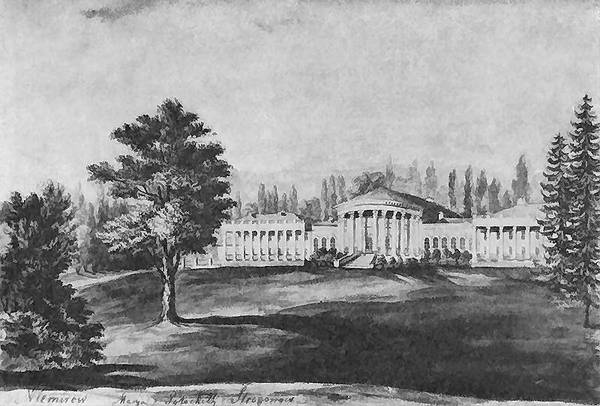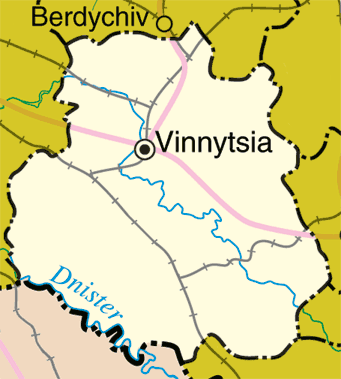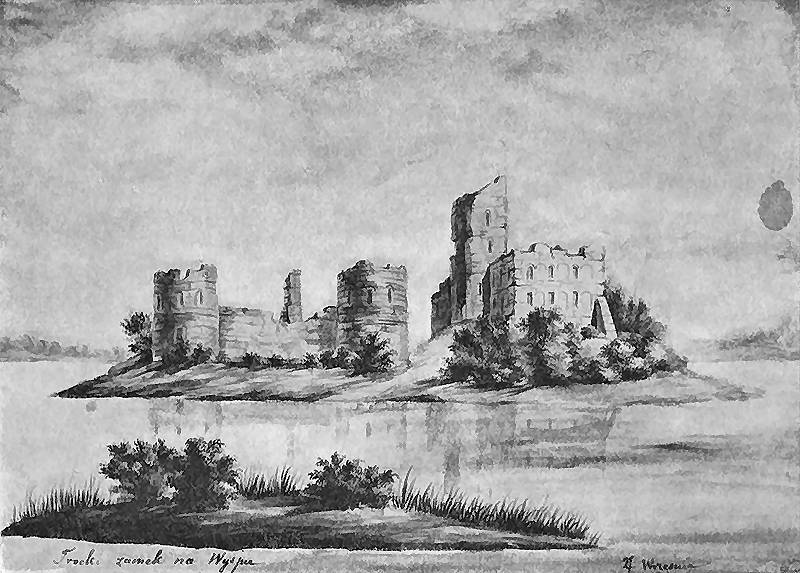|
Nemyriv
Nemyriv ( uk, Немирів, russian: Немирoв, pl, Niemirów) is a historic town in Vinnytsia Oblast (Oblast, province) in Ukraine, located in the historical region of Podolia. It was the Capital city, administrative center of former Nemyriv Raion (Raion, district). Population: Nemyriv is one of the oldest cities in Vinnytska oblast, Ukraine. It was founded by Prince Nemyr in 1390. It is a minor industrial center. The distiller company that produces Ukrainian Nemiroff (Russian spelling) vodka is located in Nemyriv. The town's tourist attractions include a late 19th-century palace (which belonged to the House of Potocki) and a park complex. History Nemyriv was built on the site of ancient Scythian settlement Myriv, destroyed during the Mongol invasion of Rus'. It was first mentioned under its modern name in 1506, which ultimately derives from the Slavic name, Slavic given name Niemir. It was a private town of Crown of the Kingdom of Poland, Poland, owned by the famili ... [...More Info...] [...Related Items...] OR: [Wikipedia] [Google] [Baidu] |
Nemyriv Raion
Nemyriv Raion ( uk, Немирівський район) (transliteration from Ukrainian Nemyrivskyi Raion) was a raion (district) in Vinnytsia Oblast, Ukraine. The administrative center of Nemyriv Raion was the town of Nemyriv. The area of the raion was 1293 square km. There were 94 settlements in the raion. The raion was abolished and its territory was merged into Vinnytsia Raion on 18 July 2020 as part of the administrative reform of Ukraine, which reduced the number of raions of Vinnytsia Oblast to six. The last estimate of the raion population was References Notes Sources Official Nemyriv Raion webpageOfficial page of the Nemyriv Raion state administrationOfficial page of the Vinnytsia Oblast state administration Former raions of Vinnytsia Oblast 1923 establishments in Ukraine Ukrainian raions abolished during the 2020 administrative reform {{Vinnytsia-geo-stub ... [...More Info...] [...Related Items...] OR: [Wikipedia] [Google] [Baidu] |
Nemiroff
Nemiroff is a Ukrainian vodka brand, one of the world's largest producers of alcohol. The products are sold in more than 80 countries. The company is one of the top3 world leaders in supplying vodka to duty-free shops (Duty Free). The brand is #1 exporter of all vodka drinks from Ukraine and is within the top100 taxpayers in Ukraine. Nemiroff achieved the Distillery of the Year accolade at the international tasting competition, the Berlin International Spirits Competition 2020. Nemiroff secured the Vodka Brand Champion title in 2021. The brand delivered 12% growth, increasing its volume to 5.6 m in 2021. According to the data of the authoritative IWSR TOP100 rating, the Nemiroff brand topped the rating of the fastest-growing international spirits brands in the world. The shareholders of Nemiroff are Yakov Finkelshtein, Bella Finkelstein and Anatoliy Kipish. From November 2018 it is the official sponsor of the UFC. Production and bottling of Nemiroff beverages is carried ou ... [...More Info...] [...Related Items...] OR: [Wikipedia] [Google] [Baidu] |
Vinnytsia Oblast
Vinnytsia Oblast ( uk, Ві́нницька о́бласть, translit=Vinnytska oblast; ; also referred to as Vinnychchyna — uk, Ві́нниччина) is an oblast of western and southwestern Ukraine. Its administrative center is Vinnytsia. The oblast has a population of History Vinnytsia Oblast, first established on February 27, 1932, originally comprised raions (regions) of the following former okruhas of Ukraine (districts of Soviet Ukraine): * Uman Okruha * Berdychiv Okruha * Vinnytsia Okruha * Mohyliv Okruha * Tulchyn Okruha * Shepetivka Okruha * Proskuriv Okruha * Kamianets Okruha In 1935 bordering territories of the oblast were transformed into Soviet border districts: Shepetivka Okrug, Proskuriv Okrug, and Kamianets Okrug. In 1937 the Kamianets Oblast, based on the border districts, was formed (it later became Khmelnytsky Oblast). During World War II the occupying Axis powers split the territory of Vinnytsia Oblast between the General District Shitomir (Zhyto ... [...More Info...] [...Related Items...] OR: [Wikipedia] [Google] [Baidu] |
Myriv
Myriv was an ancient (Iron Age) Scythian settlement in Ukraine. It was one of the largest Scythian cities in Ukraine between the rivers of Dniester and Dnieper. It was founded 800-750 BC. In 900-1250 AD it was a Ruthenians, Ruthenian settlement of Kyivan Rus. The city was destroyed during the Mongol invasion of Rus. After the Mongols left Kyivan Rus (Ukraine), the city was rebuilt at other place. It was first mentioned under its modern name of Nemyriv in 1506. {{coord, 48.9483, N, 28.8908, E, source:wikidata, display=title Ancient history of Ukraine Scythians Iron Age Europe Iranian archaeological sites Nemyriv Archaeological sites in Ukraine ... [...More Info...] [...Related Items...] OR: [Wikipedia] [Google] [Baidu] |
Niemir
Niemir, Niemirz, Niemierz – is a male Slavic given name Given names originating from the Slavic languages are most common in Slavic countries. The main types of Slavic names: * Two-basic names, often ending in mir/měr (''Ostromir/měr'', ''Tihomir/měr'', '' Němir/měr''), *voldъ (''Vsevolod'', ... of Proto-Slavic Language, Old Slavic origin, present in other Slavs, Slavic nations (in different forms and spellings). The name is composed of ''nie-'' (a negation) as well as ''-mir'' ("peace", "good", "great", "famous"), present in a number of other Slavic given names such as ''Mirogniew'' and ''Mirogod'' and related to Gothic language, Gothic naming element ''mērs'', ''-mir'', c.f. Theodemir, Theode''mir'', Valamir, Vala''mir''. Medieval texts from Mazovia often substitute this given name in the form of ''Niemierza'' as Erasmus (other), Erasmus, a male given name derived from Ancient Greek. The name day for Niemir is celebrated on February 14 in Poland.A. ... [...More Info...] [...Related Items...] OR: [Wikipedia] [Google] [Baidu] |
Napoleon Orda
Napoleon Mateusz Tadeusz Orda ( be, Напалеон Орда; lt, Napoleonas Orda; 11 February 1807 – 26 April 1883) was a Polish-Lithuanian musician, pianist, composer and artist, best known for numerous sketches of historical sites of the former Polish–Lithuanian Commonwealth. Biography Napoleon Orda was born in the village of Varacevičy in the Pinsky Uyezd of Minsk Governorate (now in Ivanava District of Belarus) in his father's manor. His father, Michał Orda, was an impoverished noble of Lithuanian ancestry and the marshal of the powiat of Kobryn. After finishing Svislach gymnasium in 1823, he started mathematical studies at the Imperial University of Vilnius. However, his university career came to an end on 27 August 1826, when he was arrested by the Russian secret police for taking part in a secret student society "Zorzanie",http://archives.gov.by/eng/index.php?id=759674 which was active in Svislach and Białystok gymnasiums. Although he was released soon afterwar ... [...More Info...] [...Related Items...] OR: [Wikipedia] [Google] [Baidu] |
List Of Dialling Codes In Ukraine
Country Code: +380 International Call Prefix: 0~0 Trunk Prefix: 0~ Zone 3 31 – Zakarpattia Oblast *31(2) – Uzhorod *312 – Chop *3131 – Mukacheve *3132 – Rakhiv *3133 – Svalyava *3134 – Tyachiv *3135 – Velykyy Bereznyy *3136 – Volovets *3141 – Berehove *3142 – Khust *3143 – Vynohradiv *3144 – Irshava *3145 – Perechyn *3146 – Mizhhirya 32 – Lviv Oblast *32(2) – Lviv *3230 – Pustomyty *3231 – Horodok *3234 – Mostytska *3236 – Sambir *3238 – Staryy Sambir *3239 – Zhydachiv *3241 – Mykolayiv *3244 – Drohobych *3245 – Stryy *3247 – Truskavets *3248 – Boryslav *3249 – Chervonohrad *3251 – Skole *3252 – Zhovkva *3254 – Kamyanka-Buzka *3255 – Radekhiv *3256 – Novoyavorivsk *3257 – Sokal *3259 – Yavoriv *3264 – Busk *3260 – Morshyn *3263 – Peremyshlyany *3265 – Zolochiv *3266 – Brody *3269 – Turka 33 – Volyn Oblast *33(2) – Lutsk *3342 – Volodymyr-Volynskyy *3344 – Novovolynsk *3346 – Stara ... [...More Info...] [...Related Items...] OR: [Wikipedia] [Google] [Baidu] |
Soviet Ukraine
The Ukrainian Soviet Socialist Republic ( uk, Украї́нська Радя́нська Соціалісти́чна Респу́бліка, ; russian: Украи́нская Сове́тская Социалисти́ческая Респу́блика, group=note), abbreviated as the Ukrainian SSR, UkrSSR, or UkSSR, and also known as Soviet Ukraine, was one of the constituent republics of the Soviet Union from 1922 until 1991. In the anthem of the Ukrainian SSR, it was referred to simply as ''Ukraine''. Under the Soviet one-party model, the Ukrainian SSR was governed by the Communist Party of the Soviet Union through its republican branch: the Communist Party of Ukraine. The first iterations of the Ukrainian SSR were established during the Russian Revolution, particularly after the Bolshevik Revolution. The outbreak of the Ukrainian–Soviet War in the former Russian Empire saw the Bolsheviks defeat the independent Ukrainian People's Republic, after which they founded ... [...More Info...] [...Related Items...] OR: [Wikipedia] [Google] [Baidu] |
Scythian
The Scythians or Scyths, and sometimes also referred to as the Classical Scythians and the Pontic Scythians, were an ancient Eastern * : "In modern scholarship the name 'Sakas' is reserved for the ancient tribes of northern and eastern Central Asia and Eastern Turkestan to distinguish them from the related Massagetae of the Aral region and the Scythians of the Pontic steppes. These tribes spoke Iranian languages, and their chief occupation was nomadic pastoralism." * : "Near the end of the 19th century V.F. Miller (1886, 1887) theorized that the Scythians and their kindred, the Sauromatians, were Iranian-speaking peoples. This has been a popular point of view and continues to be accepted in linguistics and historical science .. * : "From the end of the 7th century B.C. to the 4th century B.C. the Central- Eurasian steppes were inhabited by two large groups of kin Iranian-speaking tribes – the Scythians and Sarmatians .. * : "All contemporary historians, archeologists and li ... [...More Info...] [...Related Items...] OR: [Wikipedia] [Google] [Baidu] |
List Of Sovereign States
The following is a list providing an overview of sovereign states around the world with information on their status and recognition of their sovereignty. The 206 listed states can be divided into three categories based on membership within the United Nations System: 193 UN member states, 2 UN General Assembly non-member observer states, and 11 other states. The ''sovereignty dispute'' column indicates states having undisputed sovereignty (188 states, of which there are 187 UN member states and 1 UN General Assembly non-member observer state), states having disputed sovereignty (16 states, of which there are 6 UN member states, 1 UN General Assembly non-member observer state, and 9 de facto states), and states having a special political status (2 states, both in free association with New Zealand). Compiling a list such as this can be a complicated and controversial process, as there is no definition that is binding on all the members of the community of nations concerni ... [...More Info...] [...Related Items...] OR: [Wikipedia] [Google] [Baidu] |
Mongol Invasion Of Rus'
The Mongol Empire invaded and conquered Kievan Rus' in the 13th century, destroying numerous southern cities, including the largest cities, Kiev (50,000 inhabitants) and Chernihiv (30,000 inhabitants), with the only major cities escaping destruction being Novgorod and Pskov, located in the north. The campaign was heralded by the Battle of the Kalka River in May 1223, which resulted in a Mongol victory over the forces of several Rus' principalities as well as the remnants of the Cumans under Köten. The Mongols retreated, having gathered their intelligence, which was the purpose of the reconnaissance-in-force. A full-scale invasion of Rus' by Batu Khan followed, from 1237 to 1242. The invasion was ended by the Mongol succession process upon the death of Ögedei Khan. All Rus' principalities were forced to submit to Mongol rule and became vassals of the Golden Horde, some of which lasted until 1480. The invasion, facilitated by the beginning of the breakup of Kievan Rus' in the ... [...More Info...] [...Related Items...] OR: [Wikipedia] [Google] [Baidu] |
Polish–Lithuanian Commonwealth
The Polish–Lithuanian Commonwealth, formally known as the Kingdom of Poland and the Grand Duchy of Lithuania, and, after 1791, as the Commonwealth of Poland, was a bi-confederal state, sometimes called a federation, of Crown of the Kingdom of Poland, Poland and Grand Duchy of Lithuania, Lithuania ruled by a common Monarchy, monarch in real union, who was both King of Poland and List of Lithuanian monarchs, Grand Duke of Lithuania. It was one of the largest and most populous countries of 16th- to 17th-century Europe. At its largest territorial extent, in the early 17th century, the Commonwealth covered almost and as of 1618 sustained a multi-ethnic population of almost 12 million. Polish language, Polish and Latin were the two co-official languages. The Commonwealth was established by the Union of Lublin in July 1569, but the Crown of the Kingdom of Poland and the Grand Duchy of Lithuania had been in a ''de facto'' personal union since 1386 with the marriage of the Polish ... [...More Info...] [...Related Items...] OR: [Wikipedia] [Google] [Baidu] |





